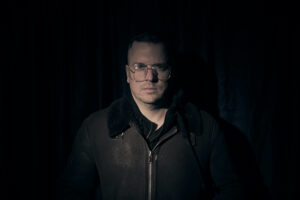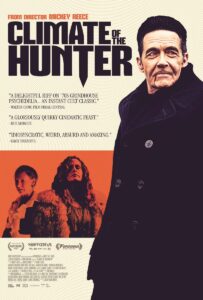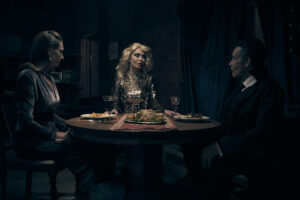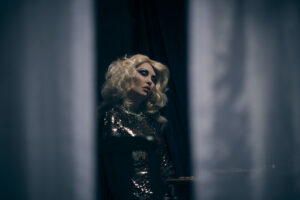Interview with “Climate of the Hunter” Director Mickey Reece
Written by: Adam Vaughn | January 12th, 2021

Close to the theatrical premiere of director Mickey Reece’s newest film, Climate of the Hunter (which I reviewed for this site), I had the opportunity to “Zoom” with Reece to discuss the movie. Climate of the Hunter tells the story of two lifelong friends, Alma and Elizabeth, as they invite over another, long-lost friend, Wesley. Relaxing and enjoying life at a secluded vacation house in the woods, Alma starts to suspect that Wesley is hiding a dark, sinister secret. As evidence starts to pile up, it becomes clear that Wesley may very well be, in fact, a vampire! Reece and I talked about the production, working with a close-knit group of actors and crew, and how the nature of filming this experimental piece influenced Reece.
Adam Vaughn: So I know that your directorial style in a lot of your biggest films so far have kind of an arthouse aesthetic or an experimental aesthetic. And Climate of the Hunter very much matches that style of experiment imagery and what not. I wanted to ask specifically for this film where the inspiration to merge arthouse and the subgenre of vampire/horror together?
Mickey Reece: Well, have you ever tried to get money for an arthouse film?
AV: I can’t say I have, no.
MR: It’s a lot harder than trying to get money for a horror film!
(both laugh)
AV: Okay…. Well in what way! I believe you, but talk to me a little more about that.

MR: Well it’s not like…. This one wasn’t easy to get money for either because people were looking at the [script] and saying “We can’t throw money at this! It doesn’t make any sense.” It’s the thing of the budget level. Not to be a hack or anything but I’m not a big fan of horror movies. Like you said, all of my films are all arthouse sensibilities. But I wanted to hopefully work on getting a bigger budget. I want to grow, I want to see what I can do with more money, and it was kind of like “Well the best thing at this level is to…” I’m talking about jumping from $20,000 to $100,000. I’m not trying to jump to $3 million, because I’m either not that experienced to work with a bigger budget yet or just not that confident enough. I don’t want to be sitting around for two years trying to get a $3 million movie funded. So with this budget level, a lot of people work with horror movies. They have a built in audience, and it’s not as big of a risk to investors, if that makes sense?
AV: Yeah, it does.
MR: Where as if somebody said “I‘m gonna make this weird arthouse film that no one’s gonna see, give me the money!” So basically you’re just like “I’m gonna make an arthouse film, and it’s gonna have vampires!” You know there’s an audience there!
AV: Yeah, you draw them in with the angle of it being a vampire story, and then the audience gets to experience your style of storytelling, is that the idea?
MR: Pretty much, yeah.
AV: Cool. What kind of challenges (and I’m not assuming budget was a challenge, necessarily) did you face for this production that you would say are unique for this experience?
MR: Man … I gotta tell you, it was a breeze! It was so easy, there were never any problems. It was just the easiest thing in the world. It was like getting your family together and going to camp for a couple weeks. We all had a blast, and we all still look back at this movie fondly. We shot this in around January, early February 2019. And it’s been a while, we’ve actually shot another movie since then, me and the crew ( and a lot of the same actors). But yeah we look back on that movie like it was a special experience, and it was very easy. I would say there were hardly any problems. Other than, you know, like I said there’s always a problem trying to get money to make a movie like this, but I think that’s always going to be a problem. If I write a script that gets funded immediately, I did something wrong!
AV: Okay, so that’s interesting, let me put a different twist on this next question. What would you say was the most unique part of filming this production? What made this production stand out in a fantastic way?
MR: Well I guess the way it started. The location was presented to me, and then it was asked “Can you work with this location?” And I was like yeah, and I wanted to work with these actors, and so I’ve got a location and I’ve got the actors. So I wrote the script around them, as opposed to writing a script and saying, “How can I get this made?” And that’s not necessarily unique to me, I’ve always done movies like that based on what my resources are, and I’ll write the script about that. But I’ve said that a few times in several interviews, and people are always surprised that this was the process. So I guess that can be considered “unique.”
AV: Cool, very cool. So from my knowledge of experimental and expressionistic filmmaking, the style relies a lot on strong imagery, which I definitely saw in Climate of the Hunter. What was the process for figuring out what visual elements you wanted to incorporate in the film?

MR: Well I hate to tell you this, because I don’t have a clear answer for that. It’s basically in my subconscious, and you just know what the scene is supposed to look like, but once again you’re choosing it based on what resources you have. So I guess coming up with ideas for the imagery, the ideas are there and then you go to film it and…. and I don’t necessarily know that I have full control but more so a feeling and I try to capture that. As opposed to just a straight idea like “there’s a red wall and then there’s a person in front of it, a light behind them, etc.” It doesn’t go that far, it’s based on however I feel in the day and when we’re filming the scene, and you create around that. So the imagery kind of creates itself, and you have to trust your gut enough to say “Yes, that’s the image that will sell this feeling!”
AV: Does that mean you shot this film a lot of times non-sequentially?
MR: Oh yeah, we had to. One day I’ll shoot a movie that you can film just from beginning to end, that would be ideal! But no, the first scene we shot was very much towards the end, like a blowup fight between two characters. Living in the cabin was one of the first scenes we shot, and the dream sequence was the next thing. But no, that would be awesome to one day shoot a film in order like that!
AV: Awesome! So speaking of the characters, what inspiration…. A lot of the characters are specific and it sounds like a very intimate cast that you prefer working with. What was the inspiration for coming up with these characters?
MR: It was based around the cast.
AV: There was a pretty significant discussion amongst you and the actors.
MR: Well that and I wrote for them, with them in mind, playing to their strengths. I knew Ben [Hall] would have to be a vampire at some point! (Laughter from both of us) he’s a very suave man. So I figured he’s my guy for a vampire. And the actors overall informed the writing and the creation of the characters.
AV: Very cool. So we talked about this a little bit inadvertently, but the “cabin in the woods” as a location. It’s very unique that you have characters isolated in the woods. Was there ever any sort of options for location (suburbs, city, etc.) or was it just fate bringing you towards filming in the cabin?

MR: That was the location presented to me, and the “Can you work with this?” to which I said “Yeah, I can keep them all in a cabin for an hour and a half.” Basically, for low budget filmmaking, you don’t get to choose. I mean you can choose, but you may not get the best results. So you create and set boundaries and rules for yourself, but I find it easier to create that way. Like “Okay, they can’t get out of the cabin, so they have to talk.” And then we write down their words. Whereas if the sky was the limit, it get s harder for me to create. Because then the options are endless so why would you ever stop writing. It doesn’t even have to limit itself to a structure.
AV: And you guys filmed and basically stayed at the cabin?
MR: For two weeks, yeah. Just like camp!
AV: Was that the first time you’ve ever had that nature of a filmmaking process, where you guys were on set but also in a specific area for a time?
MR: Yeah, I think that’s probably unique for a lot of film sets, the way we did it. But that’s exactly how it was, and like I said it was like a family, like a “family camp.
AV: Very cool. So I have one last question, and we’ll see where this takes us for the conclusion. So Wesley and Percy as characters….. Going through the film I couldn’t help but notice that they had a lot of the classic dynamic between Dracula and Dracula’s son. You know you have Dracula who’s more of the “sinister intention” vampire, and then his son who tends to be the more “docile” or “harmless” character. I couldn’t help but notice the dynamic between Wesley and Percy. Was that something you were hoping to reflect with these two?
MR: Well they have to be at odds somehow. And the whole movie is structured on the typical Dracula formula, it’s just we had fun with it.. And we got interested in other things. We kept the formula the same, having a Van Helsing character in BJ Beavers, having the damsel in distress, having the charming vampire, all of these elements are there, and of course Percy the son. All of the elements are there, it’s just we got interested in other things. We got interested in what the characters were eating, or what the characters felt about growing old… we got off on other tangents because we found those things interesting. And basically Percy had to be at odds with Wesley, that was the whole point of the dynamic. I think it was more just kind of getting the characters together and getting the characters talking. I don’t think there was any clear intention or something that we were trying to establish other than “these are the characters, this is the dynamic, this is what they have to say.” Because the movie is meant to be aimless, plotless, because it’s just a hangout movie, with a vampire.

AV: No, I like that, because it kind of disrupts the beginning/middle/end to it and has more of a natural flow. You know, like it really feels like this is the time passing for characters that are isolated in the woods for an amount of time. I did wang to go back to the food, because that definitely stuck out to me as very intriguing. And there’s a specificity to the food that’s audio narrated to the food that’s on the table for that sit-down, that was very interesting. And I’m wondering if these foods had a metaphorical significance to what they’re eating at the time, or does each meal sort of represent what’s going on or reflect the characters? Or was it more a visual representation?
MR: Kaitlyn Shelby, she’s the production designer, she’s [also] the one who prepared all the food. I told her, at these dinners, they need to be eating something really ridiculous. Just to create our own world out of it. Ridiculous in the vein of Beetlejuice, where it looks like their food is going to come out and grab them. I wanted it to be this horrifying, disgusting food. [Kaitlyn] showed me these 70’s recipes and I said “Cool, that will work.” And then the day of the first dinner scene that we shoot, she cooks it and gets it on the table, and we’re just all laughing at how disgusting this [meal] looks. And I say “Well, we gotta get a presentation shot of this!” And as we get this shot, Kaitlyn has this little baby voice, so she says (imitating her voice, saying the meal title out loud). And I was like “Oh, we’ve GOT to get you announcing every meal because that’s hilarious!” I wish there were more to it than that, but that’s what it is. It was just a really funny aesthetic that we found funny at the time.
AV: No, that is hilarious! And I definitely remember seeing some of the food items and going “Woah, what is that??” That was the reaction, just “What is that?!”
MR: And I think that…. They’re all comedies! Everything I’m trying to make is all comedies, but ‘m trying to mask the joke where it’s not just all out ridiculous. And I think because of the nature of the type of film it is, you go into it thinking it’s going to be this very serious arthouse film, and so you’re watching it that way, and people get alarmed when the tone shifts, whenever there’s some ridiculous “joking” tone shift. And sometimes it doesn’t hit with every audience member but they’re essentially there to have fun and make you laugh.
AV: And if nothing else it sounds like, I believe you mentioned this, but it sounds like you’re trying to offset the audience a little bit. People are going in with this expectation of this seriousness and you’re kind of offsetting them or surprising them with these elements.

MR: Well the idea is to show them something they’ve never seen. Because why would you want to, for the kind of money you’re working with in a low budget film, why would you adhere to “look how much of a Hollywood movie I can make with this low money” and a lot of people try to go that route. “Look it’s just like a Hollywood movie, but we did it with less money!” But you can always tell, because you’ve got something to compare it to. But if you’re making a movie, or watching a movie, that you’ve never seen anything like it, then you don’t have anything to compare it to. I think if you’re making a low budget movie, then make it low budget. Make something different. The idea behind filmmaking in general should be to explore the language of film, and kind of make it your own.
AV: I like that, for like a low-budget “philosophy,” [the idea of] thinking about what I can show that hasn’t been seen before.

